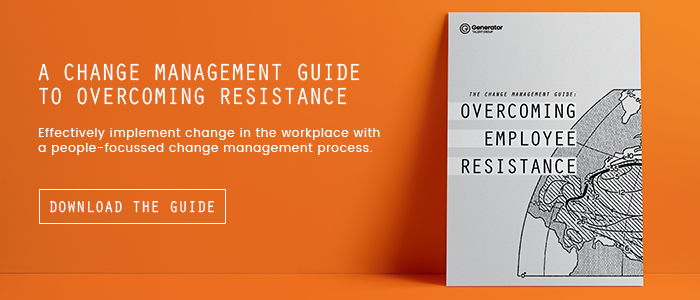26th July 2017
6 ways to empower leaders with an agile organisation structure
The current wave of organisational restructuring in contemporary business means empowering leadership has never been more important. Change management techniques focussing on facilitating agile team roles are stretching leaders in new and creative ways.
In traditional organisations built on hierarchy and structure, a leader’s role is to determine what needs to be done and then manage it to completion. This traditional leadership structure can be problematic:
- Poor management impacts directly on employee retention
- Micromanagement can stifle results and creativity, resulting in poor company performance
As a result of the consequences of a slow and stiff traditional top-down approach, a lot of companies are looking at corporate restructuring to shift to an agile organisation model. This includes famous names like GE, John Deere, Saab – and new kids on the block Airbnb and Spotify – who enjoy the benefits of a fluid structure and flexible workforce.
The anatomy of an agile organisational structure
Adopting an agile organisational structure involves the following key shifts within teams:
- Engagement rather than management
- Encouraging self-organisation and self-direction
- Decreased hierarchy and a focus on dynamic systems
- Transparent communication and minimal bureaucracy
- Focussing on a shared purpose
Why aim for an agile structure?
Clearly, these are significant changes that will force a reinvention of your organisation. So why would you want to pursue organisational restructuring to adopt agile team roles?
At a strategic level, agile teams are more progressive and creative, producing faster innovations for both products and services.
At an operational level, agile teams are more efficient and motivated; thriving on autonomy to learn quickly and develop innovative processes. As a result, teams are more productive and happy; resulting in increased employee retention.
6 ways an agile organisational structure can empower leaders
1. Ensure diverse cross-functional teams
One of the effects of a traditional hierarchy is a focus on specialists. In contrast to this, building agile team roles requires more varied skillsets in your employees.
To ensure the diversity of your teams you should focus on developing both cognitive diversity (skills, knowledge and abilities) and personality diversity (including: responses to new situations, reliability, energy levels, friendliness and emotional stability).
2. Eliminate organisational layers
Stripping the layers of management between the CEO and the doers is important for creating agile teams.
If the key to agile organisations is to have self-organising and cross-functional teams, then empowering leadership and providing personal authority and accountability is crucial.
Make sure you challenge the role – and need for – middle managers. Nominate lower level change champions to help implement new initiatives. Also think about converting separate departmental support teams to become shared-service groups.
3. Let teams set their own sub-goals and methods
Gaining faster delivery times from self-organising teams requires giving up some control and empowering leadership. Whilst teams need to be held to account for the results they produce, they must also be given the freedom to choose how they get work done.
This will require flexible and transparent communication – particularly as you begin this process and when working with junior staff. A simple strategy here is to encourage regular team meetings.
4. Rethink the basis of rewards
In line with the specialised workforce of a traditional hierarchy is a focus on individual rewards and goals.
As part of your corporate restructuring to agile team roles you will need to adjust the way you compensate your employees to reflect the shift to team projects and working together.
Previously, individual leaders were rewarded based on achievements unique to their role. Make sure you now reward team players who benefit team performance or exhibit outstanding agile leadership qualities.
5. Adopt digital team-based tools
One essential change management technique is to ensure that the intended way of working is supported by new tools. Agile teams should leverage a host of online software options that will facilitate collaboration and information sharing.
Here are three digital team-based tools to consider:
- Slack: This online tool can trump traditional closed email threads by letting all agile team members see communications relevant to their project.
- Evernote: Use this cloud-based filing system to capture and store the key documents for projects, including notes from team meetings. Use tags to make things easy to find.
- Asana: This is one of many cloud-based project management tools you can use to help your teams create and manage their own tasks. Plus, you can check in at any time to see their current status.
A strong strategy for implementing these new team-based tools is to train champions who are experts in their use and can guide others to use them effectively.
6. Communicate shared vision and values from top leaders
In a top-down organisation, the ‘boss’ or manager is responsible for instilling a focus on the strategy, vision and direction – usually through control and telling people what to do.
When you undertake an organisational restructuring to focus on agile team roles you will need to communicate the shared vision in different ways. A key shift here is from giving specific instructions to using stories and a narrative that provide clear guidance and get buy in from teams.
Moving to an agile organisation
All corporate restructuring requires a full toolkit of change management techniques.
But it’s worth remembering that a shift from a top-down ‘tell them what to do’ approach to self-organising and agile teams is not just the latest corporate fad.
Instead it’s a fundamental historical shift. And as a result, the likelihood that your employees will exhibit some sort of emotional resistance to this change is strong.
To avoid employee retention problems as you make this shift be sure to manage the emotional aspect of your organisational restructuring. You may find our latest eBook on overcoming emotional resistance during organisational change useful in this regard.
Categories: Developing Leaders




